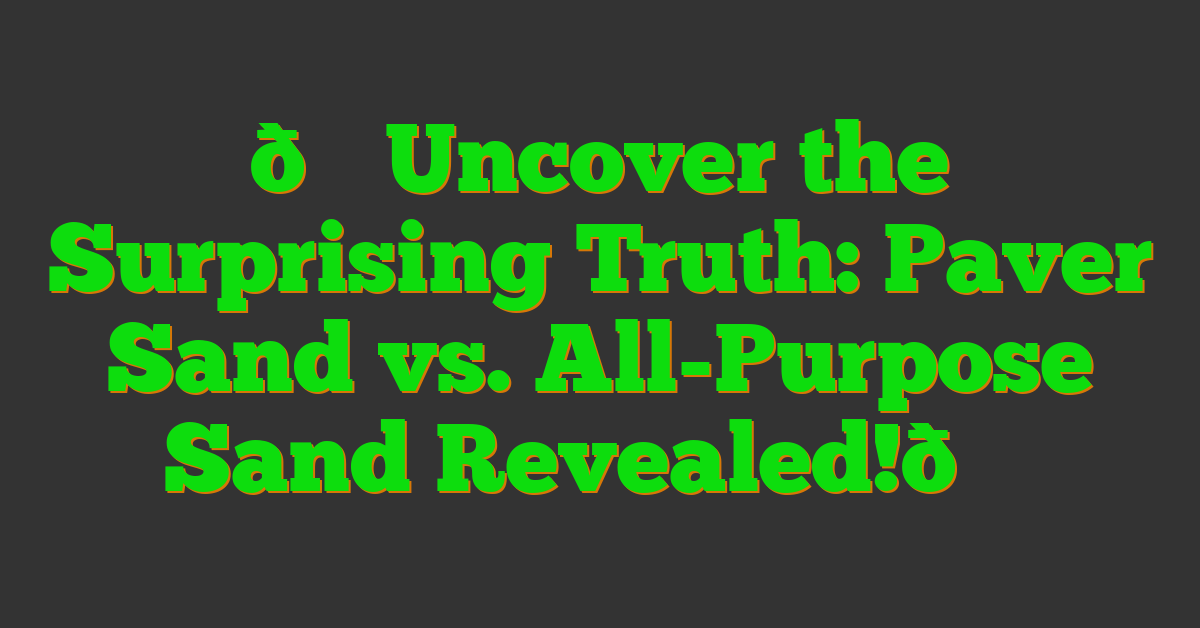When it comes to DIY landscaping projects or laying down a new patio, choosing the right type of sand is crucial for a successful outcome. In our article, we’ll explore the key differences between paver sand and all-purpose sand, helping you make an informed decision for your next project. Understanding the unique characteristics of each type of sand can save you time and effort in the long run.

Paver sand, also known as jointing sand, is specifically designed for filling the gaps between pavers, providing stability and preventing weed growth. On the other hand, all-purpose sand is more versatile and can be used for a variety of general landscaping purposes. By knowing when to use paver sand versus all-purpose sand, you’ll ensure that your project is not only visually appealing but also durable and long-lasting.
Understanding Sand Varieties
As landscape designers, we know the significance of selecting the right type of sand for our projects. Whether it’s filling gaps between pavers or creating a stable base for our installations, choosing the correct sand is crucial for achieving optimal outcomes. Let’s delve into the specific features of paver sand and all-purpose sand to better understand their distinct qualities and applications.
Paver Sand Features
When it comes to paver sand, we’re looking for specific characteristics that cater to the requirements of filling joints between pavers. Paver sand is coarse and contains larger particles, allowing it to lock into place tightly. Its angular grains interlock well, providing stability and preventing erosion over time. Paver sand is often designed to be washed, ensuring that it remains clean and free of debris, maintaining the integrity of the paved surface.
All-Purpose Sand Features
On the other hand, when we consider all-purpose sand, versatility is key. All-purpose sand offers a finer texture compared to paver sand, making it suitable for a wide range of landscaping applications beyond just filling paver joints. This type of sand is ideal for various projects such as creating a base for concrete slabs, improving soil drainage, or even as a foundational layer for laying bricks or stones. Its fine texture allows for better compaction, making it a reliable choice for multiple landscaping tasks.
Key Characteristics of Paver Sand
Granule Size and Shape
When it comes to paver sand, we know that the granule size and shape play a crucial role in its performance. Paver sand typically consists of coarse particles that interlock efficiently, providing stability and preventing erosion between pavers. With its larger granules, paver sand creates a sturdy base that enhances the durability of your landscaping project. This unique feature ensures that your paved surfaces remain intact and structurally sound over time, giving you peace of mind knowing that your hard work will stand the test of time.
Binder Content
As landscape designers, we understand the significance of the binder content in paver sand. The binder content in paver sand helps to hold the particles together, forming a cohesive structure that resists shifting and settling. This characteristic is especially important for filling the joints between pavers, as it contributes to the overall strength and integrity of the paved surface. By selecting paver sand with the right binder content, you can ensure that your landscaping project stays firmly in place, even in high-traffic areas.
Color Variations
In our experience, we have observed that paver sand comes in a variety of color variations that can complement the aesthetic appeal of your outdoor space. Whether you prefer a traditional look with beige tones or a more modern approach with gray hues, there is a color option to suit every design preference. By choosing the right color of paver sand, you can enhance the overall appearance of your paved areas, creating a cohesive and visually appealing landscape that reflects your style and personality.
Key Characteristics of All Purpose Sand
Versatility in Use
When it comes to all-purpose sand, we truly appreciate its versatility in landscaping projects. This sand type is like a multi-tool in our toolkit, ready to serve various purposes with ease. Whether it’s leveling the ground for a patio, creating a base for walkways, or enhancing drainage in a garden, all-purpose sand is our go-to choice for many tasks. Its adaptability across different applications makes it a reliable option for a wide range of landscaping needs.
Texture and Composition
The texture and composition of all-purpose sand play a significant role in its effectiveness for landscaping. With a finer grain size compared to paver sand, this type of sand feels smoother to the touch. Its uniform particles allow for even distribution, making it ideal for applications where a more consistent surface is desired. Additionally, the composition of all-purpose sand enables it to blend seamlessly with other materials, ensuring a cohesive finish in landscaping projects.
Moisture and Packing Attributes
One of the key characteristics we value in all-purpose sand is its moisture retention and packing attributes. This sand type has a moderate capacity to retain moisture, which is beneficial for supporting plant growth and maintaining soil health. Additionally, the packing attributes of all-purpose sand make it compact nicely when used as a base material, providing stability and support for various landscaping elements. Its ability to hold moisture while still allowing for proper compaction makes it a reliable choice for achieving durable and well-structured outdoor spaces.
Comparing Paver Sand and All Purpose Sand
Before delving into the distinctions between paver sand and all-purpose sand, it’s crucial to understand their inherent differences, ensuring the success of our landscaping projects.
Structural Integrity for Projects
When considering structural integrity, paver sand shines in providing stability and durability due to its coarse granules, angular shapes, and high binder content. These characteristics ensure a solid base for pavers, minimizing shifting and enhancing overall longevity. Paver sand’s ability to interlock tightly offers superior load-bearing capacity, crucial for driveways, walkways, or patios where heavy foot traffic or vehicles are common.
Conversely, all-purpose sand, with its finer grains and uniform particles, is more suited for delicate projects like gardening, where a smooth texture is essential. While it may lack the coarse properties of paver sand, all-purpose sand excels in its versatility. It effortlessly blends with various materials, making it ideal for creating gradients, improving drainage in flower beds, or aiding in aeration for plant roots.
Price Differences
In terms of pricing, paver sand typically comes at a higher cost compared to its all-purpose counterpart. This variance is a reflection of the quality and specific attributes that make paver sand ideal for demanding projects that require enhanced stability and durability. While the initial investment in paver sand may be higher, its long-term benefits in terms of project integrity and longevity often outweigh the upfront expenses.
On the other hand, all-purpose sand, being more readily available and versatile, tends to be more budget-friendly. Its affordability makes it a popular choice for general landscaping tasks that do not require the specialized characteristics of paver sand. Whether it’s for leveling the ground, creating a base for pathways, or adding amendments to soil, all-purpose sand offers a cost-effective solution without compromising quality.
Application Methods
When it comes to application methods, both paver sand and all-purpose sand have distinct roles in our landscaping projects. Paver sand’s coarse texture and binding properties make it ideal for creating a sturdy base for interlocking pavers by filling the joints and providing stability. It requires proper compaction and leveling to ensure a uniform surface, essential for the structural integrity of hardscape elements.
Conversely, all-purpose sand’s finer texture and versatility make it suitable for a wide range of applications. From blending with soils to improve drainage to creating a smooth surface for laying turf or establishing flower beds, all-purpose sand adapts effortlessly to various landscaping needs. Its ability to retain moisture and support healthy plant growth makes it a valuable asset in enhancing the aesthetics and functionality of outdoor spaces.
As landscape designers, understanding the nuanced differences between paver sand and all-purpose sand empowers us to make informed decisions based on the specific requirements of each project, ultimately leading to successful and enduring landscapes.
« 🔥 Revealed: The Ultimate Guide to Keeping Your Feet Cool on Porcelain Pavers in the Blistering Sun! ☀️ Discover the Surprising Truth: Large vs Small Pavers – Which One Wins? »
Best Practices for Using Paver Sand
Preparing the Foundation
When it comes to using paver sand for landscaping projects, our experience as landscape designers has taught us the vital importance of preparing a solid foundation. Before laying paver sand, we always begin by ensuring the ground is properly excavated to the correct depth. This step is crucial in creating a stable base that promotes proper drainage and prevents shifting or settling over time. Properly compacting the soil below the sand layer is also essential to prevent any movement or unevenness in the pavers.
Applying and Setting Paver Sand
Once the foundation is well-prepared, the next step is to apply and set the paver sand effectively. We recommend starting by spreading the sand evenly over the prepared area using a screed or leveling tool. Ensuring a consistent thickness of sand beneath the pavers is key to achieving a uniform surface that supports the pavers adequately.
After spreading the paver sand, we gently moisten the surface with water to activate the binding properties of the sand. This step helps the sand to settle and create a secure, interlocking base for the pavers. Using a plate compactor, we carefully compact the sand to further enhance stability and prevent any movement or shifting of the pavers once they are installed.
Following these best practices for preparing, applying, and setting paver sand can significantly contribute to the longevity, stability, and overall aesthetic appeal of your landscaping project.
Best Practices for Using All Purpose Sand
Identifying Suitable Projects
When considering projects that require the use of all-purpose sand in landscaping, we focus on versatility and adaptability. All-purpose sand is ideal for a wide range of applications, making it suitable for various projects. Whether we are creating a base for pavers, filling in gaps between stones, or leveling the ground for a garden bed, all-purpose sand proves to be a versatile choice. Its fine texture and ability to compact make it perfect for smaller-scale projects that demand precision and a smooth finish.
Mixing and Application Tips
To ensure the successful use of all-purpose sand, we follow essential mixing and application tips. It’s crucial to first moisten the sand slightly before use, as this aids in proper compaction and binding. When mixing all-purpose sand with other materials like soil or gravel, we aim for a homogeneous mixture to achieve uniformity in the project. During application, we spread the sand evenly, ensuring a consistent layer across the desired area. By compacting the sand gently as we work, we enhance its stability and create a solid foundation for the landscaping project. Remember, a thorough understanding of the characteristics and application techniques of all-purpose sand is key to achieving a professional and long-lasting result.
When to Choose Which Type of Sand
As landscape designers, we understand the critical role that sand plays in various landscaping projects. Knowing when to opt for paver sand over all-purpose sand is key to achieving successful outcomes. Here’s our expert advice on the optimal uses for each type of sand in landscaping projects:
For High-Traffic Areas: Paver Sand
When working on projects that experience heavy foot traffic or vehicle loads, such as driveways, walkways, or patios, opting for paver sand is crucial. Its coarse texture and binding properties make it ideal for locking pavers in place, providing stability and durability in high-traffic zones.
For Delicate and Versatile Projects: All-Purpose Sand
In situations where flexibility and adaptability are paramount, all-purpose sand shines. This type of sand is perfect for delicate projects like gardening, leveling ground, or filling gaps between pavers in less demanding areas. Its ability to blend effortlessly with other materials makes it a go-to choice for versatile landscaping projects.
By understanding the distinctive characteristics and applications of paver sand and all-purpose sand, we can make informed decisions that lead to professional and long-lasting results in our landscaping endeavors.
Conclusion
Choosing the right sand is key to successful landscaping projects. Paver sand offers stability and durability, ideal for high-traffic areas like driveways and patios. On the other hand, all-purpose sand’s versatility makes it perfect for delicate projects such as gardening. By understanding the unique qualities of each type of sand, we can ensure professional and long-lasting results in our landscaping endeavors. Remember, selecting the appropriate sand can make a significant difference in the outcome of your project.
















